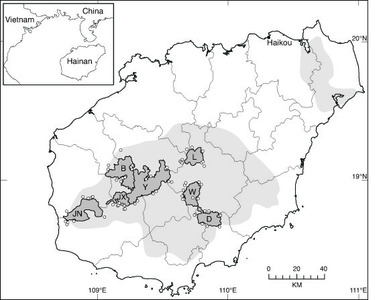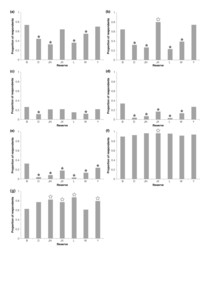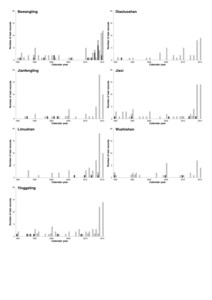Turvey, ST;
Bryant, JV;
Duncan, C;
Wong, MHG;
Guan, Z;
Fei, H;
Ma, C;
... Fan, P; + view all
(2017)
How many remnant gibbon populations are left on Hainan? Testing the use of local ecological knowledge to detect cryptic threatened primates.
American Journal of Primatology
, 79
(2)
, Article e22593. 10.1002/ajp.22593.

Preview |
Text (Accepted manuscript)
Turvey_Turvey_et_al_gibbon_interviews_revised_text_final.pdf Download (379kB) | Preview |
![[thumbnail of Figure 1]](https://discovery.ucl.ac.uk/1508449/3.hassmallThumbnailVersion/Turvey_et_al_gibbon_interviews_Fig1.jpg)  Preview |
Image (Figure 1)
Turvey_et_al_gibbon_interviews_Fig1.jpg - Accepted Version Download (660kB) | Preview |
![[thumbnail of Figure 2]](https://discovery.ucl.ac.uk/1508449/8.hassmallThumbnailVersion/Turvey_et_al_gibbon_interviews_Fig2.jpg)  Preview |
Image (Figure 2)
Turvey_et_al_gibbon_interviews_Fig2.jpg - Accepted Version Download (311kB) | Preview |
![[thumbnail of Figure 3]](https://discovery.ucl.ac.uk/1508449/18.hassmallThumbnailVersion/Turvey_et_al_gibbon_interviews_Fig3.jpg)  Preview |
Image (Figure 3)
Turvey_et_al_gibbon_interviews_Fig3.jpg - Accepted Version Download (310kB) | Preview |
![[thumbnail of Figure 4]](https://discovery.ucl.ac.uk/1508449/13.hassmallThumbnailVersion/Turvey_et_al_gibbon_interviews_Fig4.jpg)  Preview |
Image (Figure 4)
Turvey_et_al_gibbon_interviews_Fig4.jpg - Accepted Version Download (81kB) | Preview |
Preview |
Text (Supplementary information)
Turvey_Turvey_et_al_gibbon_interviews_SI_revised.pdf Download (341kB) | Preview |
Abstract
For Critically Endangered “species of extreme rarity,” there is an urgent need to clarify the potential survival of remnant populations. Such populations can be difficult to detect using standard field methods. Local ecological knowledge (LEK) represents an important alternative source of information, but anecdotal reports of rare or possibly extinct species can contain uncertainty and error. The Hainan gibbon (Nomascus hainanus), the world's rarest primate species, is confirmed to only survive as a tiny remnant population in Bawangling National Nature Reserve, China, but unverified gibbon sightings have been reported from other forest areas on Hainan. We conducted a large-scale community interview survey to gather new data on patterns of primate LEK from 709 respondents around seven reserves across Hainan, to investigate the possibility of gibbon survival outside Bawangling and assess whether LEK can provide useful information for conservation management of cryptic remnant populations. Comparative LEK data for gibbons and macaques are consistent with independent data on the relative status of these species across Hainan. Local awareness and experience of gibbons was low across Hainan, including at Bawangling, but we recorded recent anecdotal gibbon reports from most reserves. A follow-up field survey at Limushan Provincial Nature Reserve did not detect gibbons, however, and documented intensive wildlife exploitation within this reserve. All other surveyed landscapes showed some statistically lower levels of respondent awareness, experience, or sighting histories of gibbons compared to Bawangling, and are therefore considered biologically unlikely to support gibbons. Unverified LEK data can provide important insights into the possible status of cryptic remnant populations when assessed carefully and critically in relation to data from known populations.
| Type: | Article |
|---|---|
| Title: | How many remnant gibbon populations are left on Hainan? Testing the use of local ecological knowledge to detect cryptic threatened primates |
| Open access status: | An open access version is available from UCL Discovery |
| DOI: | 10.1002/ajp.22593 |
| Publisher version: | http://doi.org/10.1002/ajp.22593 |
| Language: | English |
| Additional information: | Copyright © 2016 Wiley Periodicals, Inc. This is the peer reviewed version of the following article: Turvey, ST; Bryant, JV; Duncan, C; Wong, MHG; Guan, Z; Fei, H; Ma, C; (2016) How many remnant gibbon populations are left on Hainan? Testing the use of local ecological knowledge to detect cryptic threatened primates. American Journal of Primatology, which has been published in final form at http://dx.doi.org/10.1002/ajp.22593. This article may be used for non-commercial purposes in accordance with Wiley Terms and Conditions for Self-Archiving. |
| Keywords: | interview survey; last-sighting dates; Nomascus hainanus; possibly extinct; remnant population |
| UCL classification: | UCL UCL > Provost and Vice Provost Offices UCL > Provost and Vice Provost Offices > School of Life and Medical Sciences UCL > Provost and Vice Provost Offices > School of Life and Medical Sciences > Faculty of Life Sciences UCL > Provost and Vice Provost Offices > School of Life and Medical Sciences > Faculty of Life Sciences > Div of Biosciences UCL > Provost and Vice Provost Offices > UCL SLASH UCL > Provost and Vice Provost Offices > UCL SLASH > Faculty of S&HS |
| URI: | https://discovery.ucl.ac.uk/id/eprint/1508449 |
Archive Staff Only
 |
View Item |


